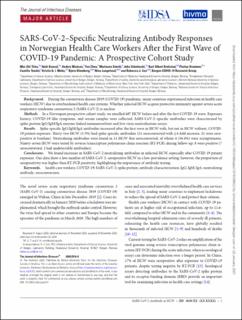| dc.contributor.author | Trieu, Mai Chi | |
| dc.contributor.author | Bansal, Amit | |
| dc.contributor.author | Madsen, Anders | |
| dc.contributor.author | Zhou, Fan | |
| dc.contributor.author | Sævik, Marianne | |
| dc.contributor.author | Vahokoski, Juha | |
| dc.contributor.author | Brokstad, Karl Albert | |
| dc.contributor.author | Krammer, Florian | |
| dc.contributor.author | Tøndel, Camilla | |
| dc.contributor.author | Mohn, Kristin Greve Isdahl | |
| dc.contributor.author | Blomberg, Bjørn | |
| dc.contributor.author | Langeland, Nina | |
| dc.contributor.author | Cox, Rebecca Jane | |
| dc.coverage.spatial | Norway | en_US |
| dc.date.accessioned | 2021-02-01T14:04:42Z | |
| dc.date.available | 2021-02-01T14:04:42Z | |
| dc.date.created | 2020-11-29T09:17:32Z | |
| dc.date.issued | 2020 | |
| dc.identifier.citation | Trieu, M.-C., Bansal, A., Madsen, A., Zhou, F., Sævik, M., Vahokoski, J., … Berg, Å. G. (2020). SARS-CoV-2–specific neutralizing antibody responses in Norwegian health care workers after the first wave of COVID-19 pandemic: A prospective cohort study. The Journal of Infectious Diseases. | en_US |
| dc.identifier.issn | 0022-1899 | |
| dc.identifier.uri | https://hdl.handle.net/11250/2725625 | |
| dc.description.abstract | Background
During the coronavirus disease 2019 (COVID-19) pandemic, many countries experienced infection in health care workers (HCW) due to overburdened health care systems. Whether infected HCW acquire protective immunity against severe acute respiratory syndrome coronavirus 2 (SARS-CoV-2) is unclear.
Methods
In a Norwegian prospective cohort study, we enrolled 607 HCW before and after the first COVID-19 wave. Exposure history, COVID-19–like symptoms, and serum samples were collected. SARS-CoV-2–specific antibodies were characterized by spike-protein IgG/IgM/IgA enzyme-linked immunosorbent and live-virus neutralization assays.
Results
Spike-specific IgG/IgM/IgA antibodies increased after the first wave in HCW with, but not in HCW without, COVID-19 patient exposure. Thirty-two HCW (5.3%) had spike-specific antibodies (11 seroconverted with ≥4-fold increase, 21 were seropositive at baseline). Neutralizing antibodies were found in 11 HCW that seroconverted, of whom 4 (36.4%) were asymptomatic. Ninety-seven HCW were tested by reverse transcriptase polymerase chain reaction (RT-PCR) during follow-up; 8 were positive (7 seroconverted, 1 had undetectable antibodies).
Conclusions
We found increases in SARS-CoV-2 neutralizing antibodies in infected HCW, especially after COVID-19 patient exposure. Our data show a low number of SARS-CoV-2–seropositive HCW in a low-prevalence setting; however, the proportion of seropositivity was higher than RT-PCR positivity, highlighting the importance of antibody testing. | en_US |
| dc.language.iso | eng | en_US |
| dc.publisher | Oxford University Press | en_US |
| dc.rights | Attribution-NonCommercial-NoDerivatives 4.0 Internasjonal | * |
| dc.rights.uri | http://creativecommons.org/licenses/by-nc-nd/4.0/deed.no | * |
| dc.subject | health care workers | en_US |
| dc.subject | COVID-19 | en_US |
| dc.subject | SARS-CoV-2 | en_US |
| dc.subject | spike protein | en_US |
| dc.subject | antibody characterization | en_US |
| dc.subject | IgG | en_US |
| dc.subject | IgM | en_US |
| dc.subject | IgA | en_US |
| dc.subject | neutralizing antibody | en_US |
| dc.subject | seroconversion | en_US |
| dc.title | SARS-CoV-2-specific neutralizing antibody responses in Norwegian healthcare workers after the first wave of COVID-19 pandemic: a prospective cohort study | en_US |
| dc.type | Peer reviewed | en_US |
| dc.type | Journal article | en_US |
| dc.description.version | publishedVersion | en_US |
| dc.rights.holder | © The Author(s) 2020 | en_US |
| dc.source.journal | Journal of Infectious Diseases | en_US |
| dc.identifier.doi | 10.1093/infdis/jiaa737 | |
| dc.identifier.cristin | 1853723 | |
| dc.relation.project | Trond Mohn Stiftelse: TMS2020TMT05 | en_US |
| dc.relation.project | Norges forskningsråd: 284930 | en_US |
| dc.relation.project | EC/H2020/874866 | en_US |
| dc.relation.project | EC/IMI115672 | en_US |
| cristin.ispublished | true | |
| cristin.fulltext | original | |
| cristin.qualitycode | 2 | |

